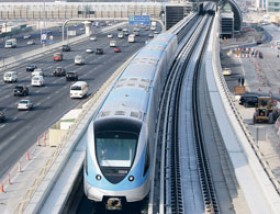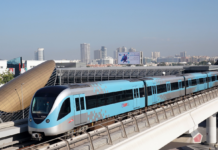By Ashfaq Ahmed, Chief Reporter www.gulfnews.com
Dubai: With the launching of the first Metro in the Gulf region, Dubai has achieved a never before attempted milestone – the world’s longest automated driverless train system built in just four years.

“The completion of such a massive project in a short period of time speaks volumes about Dubai’s economic strength and its commitment to the development of the city regardless of the global economic crisis,” said Mattar Al Tayer, Chairman of the Board and Executive Director of the Dubai Roads and Transport Authority (RTA).
Tonight there will be fireworks visible from Mall of the Emirates, Jafilliya, Creek Park and Festival City.
Dubai is now in the league of ‘mega cities.’
The aim of the Metro system is to provide an integrated public transport system to ease congestion, save travelling time for passengers, reduce traffic pollution, improve mobility within the city, provide a swift connection to Dubai International Airport and important business and commercial hubs, and deliver a modern, comfortable, reliable and safe mode of commuting.
“It took some 30,000 workers, five big contractors and 150 [other] contractors to complete and make it possible to launch the project on schedule,” Al Tayer said.
He said that the RTA revised the original design of the Metro by 50 to 60 per cent to incorporate the changing development trends in the city, and as a result the cost increased from Dh15.5 to Dh28 billion.
The Metro is set to provide transport coverage and reach all strategic areas of the city, and develop the network to branch out into the suburbs with future extensions including Al Sufouh Tram which will be ready in 2011. The future lines under study are the Purple and Blue Lines to extend the network.
The Metro will be a catalyst for the improvement of real estate values, economic development and urban regeneration along its main route and arteries. It will create an additional source of employment for both the local population as well as the region in addition to boosting the tourism sector.
Studies show that the Metro will reduce traffic congestion by 17 per cent out of a total of 30-35 per cent, which is aimed to be reduced by an integrated public transport network including buses and water transport.
As part of its modernity drive, vision and concerns for the environment due to rapid development, the Dubai government commissioned studies to determine the most efficient and cost-effective solutions to traffic congestion, which resulted in the birth of the Metro.
The seeds for the project were sown in 1992, when a feasibility study known as R400 concluded that Dubai could no longer rely solely on road expansion to cater to its escalating traffic demands. The findings recommended a transit system.
The contract to build the Metro was awarded in July 2005 to a consortium called Dubai Urban Rapid Link (DURL). The consortium comprises Japanese companies including Mitsubishi Heavy Industries, Mitsubishi Corporation, Obayashi Corporation, Kajima Corporation and Yapi Markezi of Turkey supervised by consultants Systra and Parsons from France and the US, respectively.
“We are very proud that the dream of having a Metro is being realised today as it will benefit generations to come,” said Al Tayer.
The Metro is a world-class, 21st century railway system. It is the first of its kind in the region with outstanding state-of-the-art design. The themes of the stations, interiors and the originality of the station exteriors give the Metro a pleasant mix of Dubai’s heritage and modern architecture.
Al Tayer noted that with the construction of the Metro, property and land prices around Metro stations and tracks have increased by 30 per cent.
The Metro will also help Dubai save Dh5 billion a year which is lost due to traffic jams.
“It is a way forward for sustainable development and provide easy link between businesses,” he added.
Al Tayer noted that one of the key benefits is that the RTA now has developed expertise which can be used to build the Metro networks in other emirates and even other countries. He noted that the integrated transport system including introducing more public buses, feeder bus routes and water buses was developed because it was the key to the success of the Metro.
The RTA operates around 1,300 buses on 80 routes and 25 feeder bus routes in Dubai. The number of buses will increase to 1,800 by the end of the year and to 3,000 buses by the end of next year to serve almost all areas of Dubai.
“We hope to carry 4.5 million passengers every day in our public transport by 2020,” Al Tayer added.
About not opening the complete Red Line and all the stations, he said that such big projects are always launched in phases and it is quite normal around the world.
















